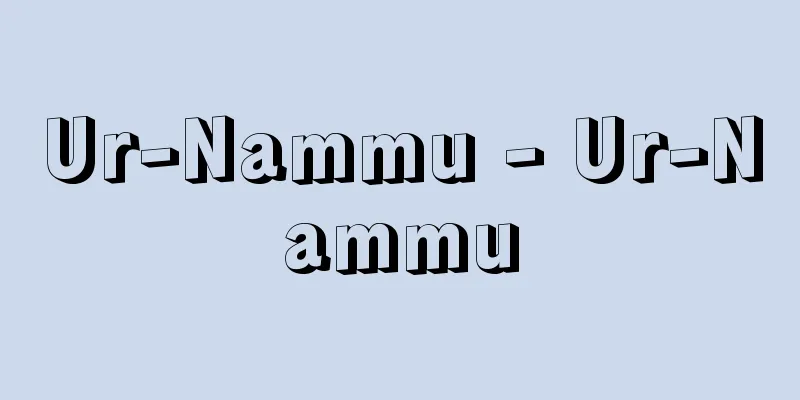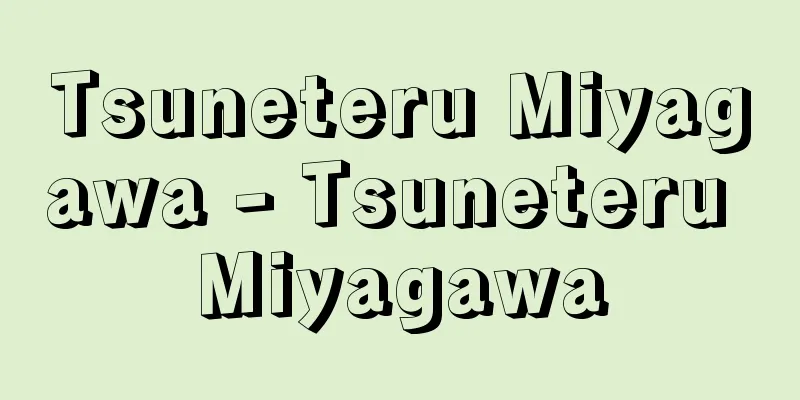Ur-Nammu - Ur-Nammu

|
...In the second half of the 22nd century BCE, the Gutians, who ruled southern Babylonia, were driven out by the Uruk ruler Utu-hegal. Later, his son (or brother) Ur-Nammu established his own kingdom in Ur, and the Third Dynasty of Ur was established. The dynasty had five kings: Ur-Nammu (reigned 2112-2095 BCE), Shulgi (2094-2047 BCE), Amar-Sin (2046-2038 BCE), Shu-Sin (2037-2029 BCE), and Ibbi-Sin (2028-2004 BCE). ... From the Code of Ur-Nammu…The oldest surviving cuneiform law code, established around 2100 BCE. It is believed to have been issued by Ur-Nammu, the founder of the Third Dynasty of Ur, and is preserved in fragments in several manuscripts from the first half of the 2nd millennium BCE. The preface proudly describes how Ur-Nammu, under the orders of Nannar, the chief god of the city of Ur, who had gained control of Sumer and Akkad, eliminated the rule of foreign tribes, corrected various irrationalities, and endeavored to protect the socially vulnerable. … From Sumer … From [Sumerian Art]...This ziggurat is a magnificent structure with a three-tiered platform, cleverly arranged stairs, and a temple on the top tier, making it one of the finest examples of Neo-Sumerian architecture. In addition, an underground tomb chamber thought to be that of Ur-Nammu, the founder of the Third Dynasty of Ur, has been discovered. Only a few reliefs remain of the sculptures. From [Imperial Tombs] ...Pyramids were revived during the Middle Kingdom during the 11th and 12th dynasties, with the largest measuring 33 metres on a side. From Babylonia ...The Gutians continued to rule over most of southern Mesopotamia, but some countries, such as Lagash, maintained their independence and prospered through trade with distant lands. It was Ut-hegal, king of Uruk, who liberated southern Mesopotamia from the Gutians' rule, but it was Ur-Nammu, who rebuilt it as a vassal of Ut-hegal and also played an active role in expelling the Gutians. From Mesopotamia…After the next king, the dynasty fell into chaos due to invasions by the Gutians, but the southern Sumer region was relatively peaceful, and Lagash in particular enjoyed prosperity. In the second half of the 22nd century BCE, Ut-hegal of Uruk drove out the Gutians, and his son (or brother) Ur-Nammu gained independence in Ur, and a unified Sumerian dynasty was established here (the Third Dynasty of Ur). The dynasty reached its zenith under the second king, Shulgi. … *Some of the terminology explanations that mention "Ur-Nammu" are listed below. Source | Heibonsha World Encyclopedia 2nd Edition | Information |
|
…前22世紀後半,南部バビロニアを支配していたグティ人がウルクの支配者ウトゥヘガルによって駆逐された。のち彼の息子(あるいは弟)のウルナンムがウルで独立し,ウル第3王朝が成立した。王朝ではウルナンムUr‐Nammu(在位,前2112‐前2095),シュルギShulgi(前2094‐前2047),アマルシンAmar‐Sin(前2046‐前2038),シュシンShu‐Sin(前2037‐前2029),イビシンIbbi‐Sin(前2028‐前2004)の5王が即位。… 【ウルナンム法典】より…現存する楔形文字法典のうち最古の,前2100年ころに制定された法典。ウル第3王朝の創立者ウルナンムが発布したと考えられ,前2千年紀前半の写本数点に断片的に伝えられている。序文では,シュメールとアッカドの支配権を得たウル市の主神ナンナルの命を受けたウルナンムが,異民族支配を一掃し,さまざまな不合理を正して社会的弱者の保護に努めたことが誇らかに叙述されている。… 【シュメール】より… 【シュメール美術】より…このジッグラトは3段の基壇を積み上げ,階段を巧みに配置し,最上段に神殿をもうけた壮大なもので,新シュメール時代の建築のもっとも優れた例といえよう。また墳墓建築として,ウル第3王朝の創立者ウルナンムUr‐Nammuのものと思われる地下の墓室が発見されている。彫刻では少数の浮彫作品が現存しているのみである。… 【帝王陵】より…ピラミッドは第11,12王朝の中王国時代にも復活したが,最大のもので1辺33mであった。 【バビロニア】より…グティ人はそのまま南メソポタミアの大半を支配したが,ラガシュなどのように独立を保ち,遠隔地との交易で栄えた国もあった。グティ人支配から南メソポタミアを解放したのはウルクの王ウトゥヘガルであったが,これを再建したのはウトゥヘガルの家臣としてグティ人駆逐にも活躍したウルナンムであった。 【メソポタミア】より…次王ののち王朝はグティ人侵入により混乱に陥るが,南部シュメール地方は比較的平和であり,とりわけラガシュは繁栄を享受していた。 前22世紀後半,ウルクのウトゥヘガルがグティ人を駆逐し,さらに彼の子(ないし兄弟)ウルナンムがウルで独立して,ここにシュメール人の統一王朝が成立した(ウル第3王朝)。2代王シュルギのとき王朝は最盛となる。… ※「ウルナンム」について言及している用語解説の一部を掲載しています。 出典|株式会社平凡社世界大百科事典 第2版について | 情報 |
>>: Ultramicrotome (English: German) Ultramikrotom
Recommend
Mastopathy
What kind of disease is it? ●Main symptoms and cou...
Oracle Bone Science
A field of study that aims to elucidate the cultu...
Bisconcini, G. (English spelling)
...This result suggested that even if a new integ...
Ichthyology - Fish
…With the emergence of Charles Darwin in the 19th...
Onside
〘noun〙 (onside) In rugby, soccer, hockey, etc., a ...
Jenkins, GM (English spelling) JenkinsGM
...Whether the ultimate goal of the analysis is p...
Egret Flower - Egret Flower
A perennial plant of the orchid family (APG class...
vidū-śaka (English spelling) vidusaka
… [Characters] The main roles in Sanskrit drama a...
Sodnom, D. (English spelling) SodnomD
…Official name = MongoliaMongol ulusArea = 1,566,...
Artistic swimming - Artistic swimming
A type of competitive swimming. It is a sport in ...
Applet - Applet
Accessory JAVA applet A Java program that runs in ...
Auerbach, E.
… Based on this reflection, a fierce anti-French ...
Anser cygnoides (English spelling)
… [Yukio Taniguchi]. … *Some of the terminology t...
Silver sparrow - Silver sparrow imitation
A moth belonging to the order Lepidoptera and the...
Wenedy - Wenedy
…the ancestors of the Western Slavs. In Latin, th...




![Meissen [City] (English spelling)](/upload/images/67cce1c2eec9b.webp)




